Fresh exhibition ISE - new LEDs, screens in the windows and how to break the screen that does not break

Integrated System Europe is the healthiest exhibition in our hemisphere for screens, LEDs and all kinds of light-music pieces for business. We go there every year and tell us what is new.
Since we, as representatives of CROC, have access to the “secret rooms” behind the screens, we see a little more than regular visitors. In addition to the fact that beautiful, but very conditionally dressed girls and stylish managers in ties show on the stands, we also look at raw technical prototypes. They are sometimes shown by scary bearded glasses, but it is these platforms that are of the greatest interest.
')

Let's start with the LG. These guys are the platinum sponsor of the exhibition, which is why they have already the most healthy and most impressive stand, where there is always some kind of movement. Therefore, we confine ourselves to only one frame with the coolest thing they have today — a video wall with a joint thickness of only 0.9 millimeters. In general, the struggle for minimal seam in video walls has been going on for five years.
Pay attention to the screen wall joints. They have a very thin frame - a total of slightly more than one and a half millimeters, taking into account the nonideal highlighting of the side pixels. The bearded men grumbled from the stand and promised that in the next firmware the regional ones would begin to glow too. I remind you that traditional projection cubes have a distance of 0.5 mm.

And these are architectural OLED displays. In LED screens, each pixel is a physical LED, in LCD panels, each pixel is a crystal and it needs backlight, and in OLED the pixels themselves are lit. Since it is the pixel itself that burns, and the back lamp does not model it, it has become possible to get maximum contrast. Black is now black, not gray. Liquid crystals still transmit light from the backlight.
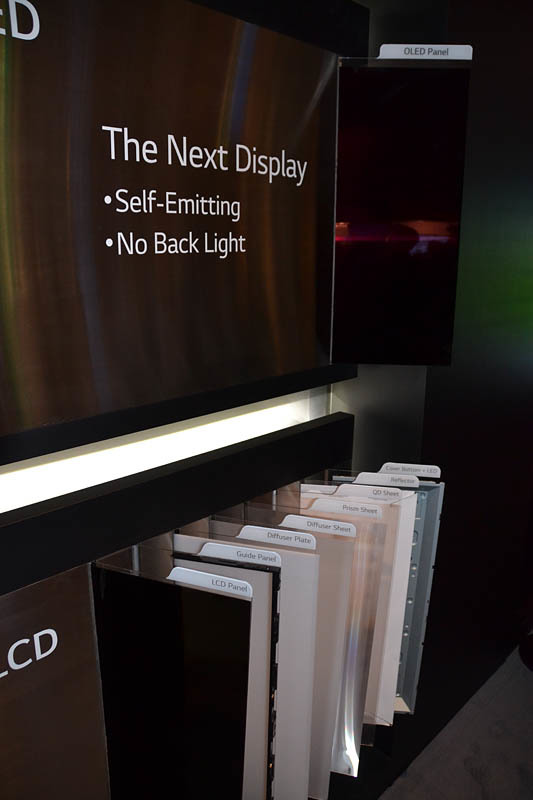
Comparison of the matrix device - at the top of the OLED, at the bottom of the LCD layers
They are architectural because they can be laid out though the dome or wrap around the columns - bends allow. Plus they are thinner and lighter than LCD. In the same place, in a closed area, we were shown a prototype of a curled OLED screen (it was impossible to shoot, so without slides). The panel itself is a “wallpaper”, from which the train leaves to a box with “brains”. By the end of the day, there was a slight kurtosis on the stand - there were a lot of people who wanted to touch and shoot the screen from the magnetic base, and they "bent it over", so on the second day it was impossible to turn it myself - only in the hands of a specially trained Korean. On the third day, we generally had to prove that we are not competitors. Apparently, just one of the competitors clearly missed the chip, enrolled as early as possible and broke a sample. A good idea.
But the OLED video walls are very thin, so now they can be made two-sided:

I must say that OLED for architecture is very cool. They do not depend on lighting (even daylight is interrupted), the heat removal is minimal, this is not superlamps for you. But the resource is not the biggest yet - it’s stated when you turn on no more than 12 hours a day for about 30 thousand hours, but they promise to bring it to 16 hours a day, or maybe 24 hours, soon. At permanent job it turns out more than three years, according to an approximate estimate.
The photo is not clear, but these things must be seen on the spot - you can get the hell out of the quality of the picture.

Here is a special order from restaurateurs and fashion designers - IPS screens were needed to adjust colors very precisely
But the concept of "augmented reality" for the refrigerator - it is clear that inside, due to the transparent screens built into the door:

Last year there were also those, but the devices became larger, and the picture was significantly brighter.
And this is a 4K-display for small control rooms. It is 98 inches, it has 4 high-resolution pictures (full HD).

Much has been done to withstand the ordinary Gopnik. Showed a lot of cold-resistant (up to -30 degrees), waterproof and difficult to break the shovel devices.

A lot of Chinese LED displays - the step has become smaller than last year, but the screens are still hanging higher, and not put in front of your eyes. By the way, the declared step of 0.9 is a marketing ploy, in fact - 0.95 mm.

The most interesting options are 0.95, in my opinion, this is the triple alliance of the Chinese Unilumin, which we agreed with Avis, plus for the content, they also “locked in” with AV Stumpfl and do everything “on a turnkey basis”. It is not clear who is in charge of this alliance, but in any case, they are tearing up the market.

And here is a comparison of two video walls:

See the flare from my flash from the edge? But the second wall and not such a stream of light normally keeps in contrast:

Because you can't argue with the LED. She has a pitch of 1.48 mm - comparable to fullHD cubes.
These are media facades for buildings:
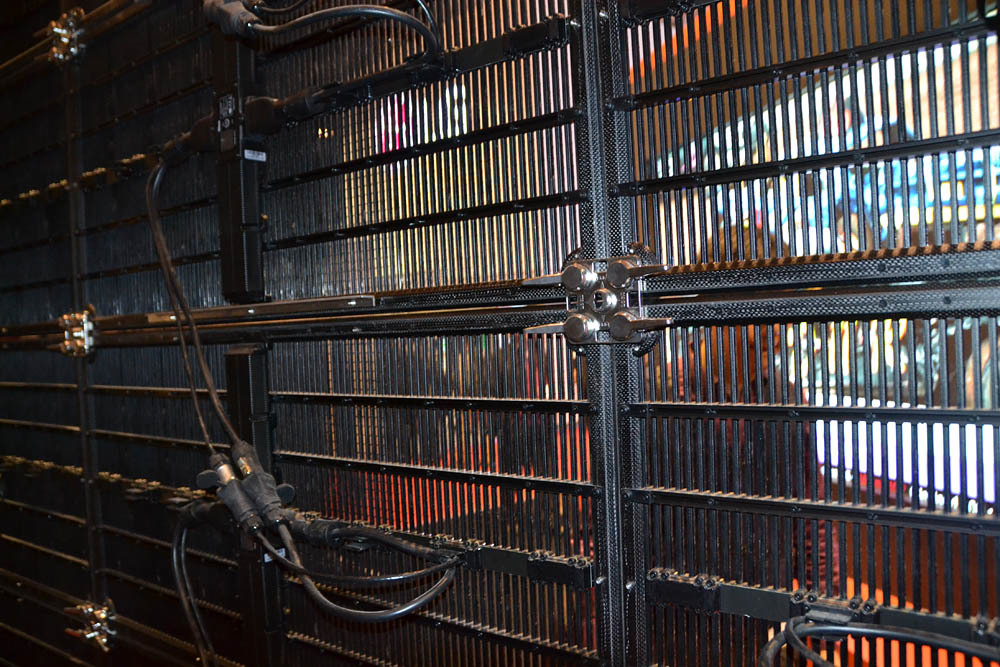
Leyard bought Planar and another company that makes facades in China, and now they make fun good panels - light, low-consumption and at the same time high-quality. All decisions now have this alliance from one source. I saw a screen of about the same quality with a comparable pixel pitch at the new stadium Spartak - the quality is excellent.
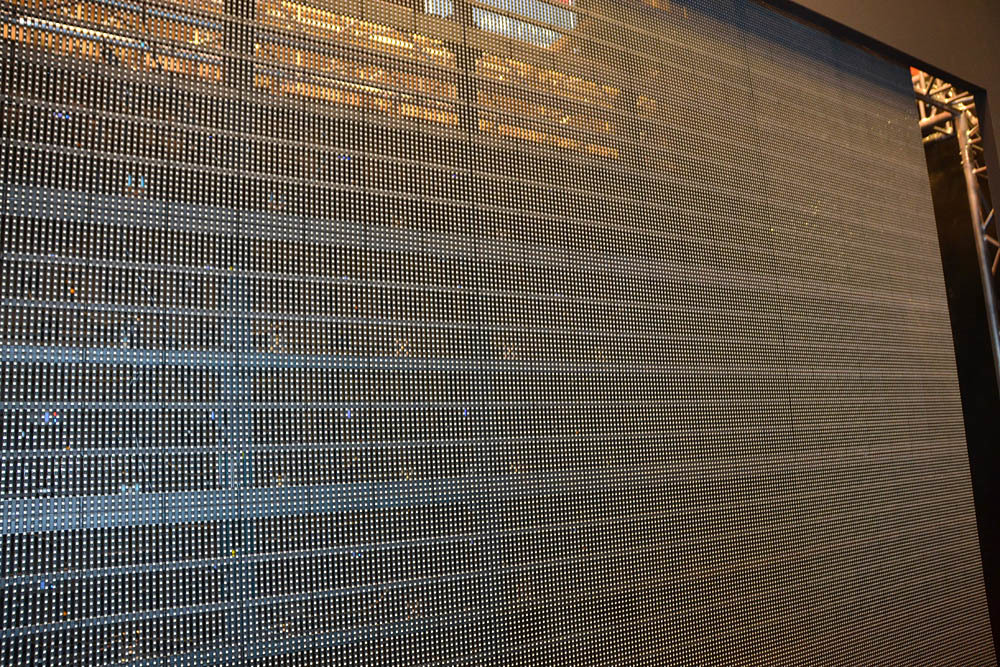
But Sharp rolled out 8K-display:

But they will not give it to anyone. They say: "You first decide what you want to do with 4K and why." Like, only learned to count and transmit, but with the content of the problem. And servaki slightly so warm the air. Therefore, you can lick, but practice is questionable.
In these video walls, the frame adaptively changes to adjacent pixels, such as an ambilight:

Takes a group of edge pixels and averaged. In the photo she just “flows” from a light frame to a dark one.

And this is the coolest touchscreen I have ever seen. What's especially cool is that Prysm has more integration with tablets. Operators' devices (below) are connected to the wall. You can open the content on your tablet and throw at all. And you can only work on the tablet. You can walk and touch in parallel. It was difficult to integrate such systems before.
Now it turns out a very useful thing for schools, museums, reports, meetings. Good bundle - everything works without problems.
They brought a lot of sports solutions for stadiums and all sorts of signs.

This is Novastar - they are the coolest in the line of receiving and transmitting devices for LED screens and in video processors for them:

All screen manufacturers recommend them: this is the only vendor that can recount a picture for any resolution. The rest say - “we have 100 templates for permissions, if you need something more, turn around as you like.”
This year showed new traveling screens, microphones and other body kit of the speaker:
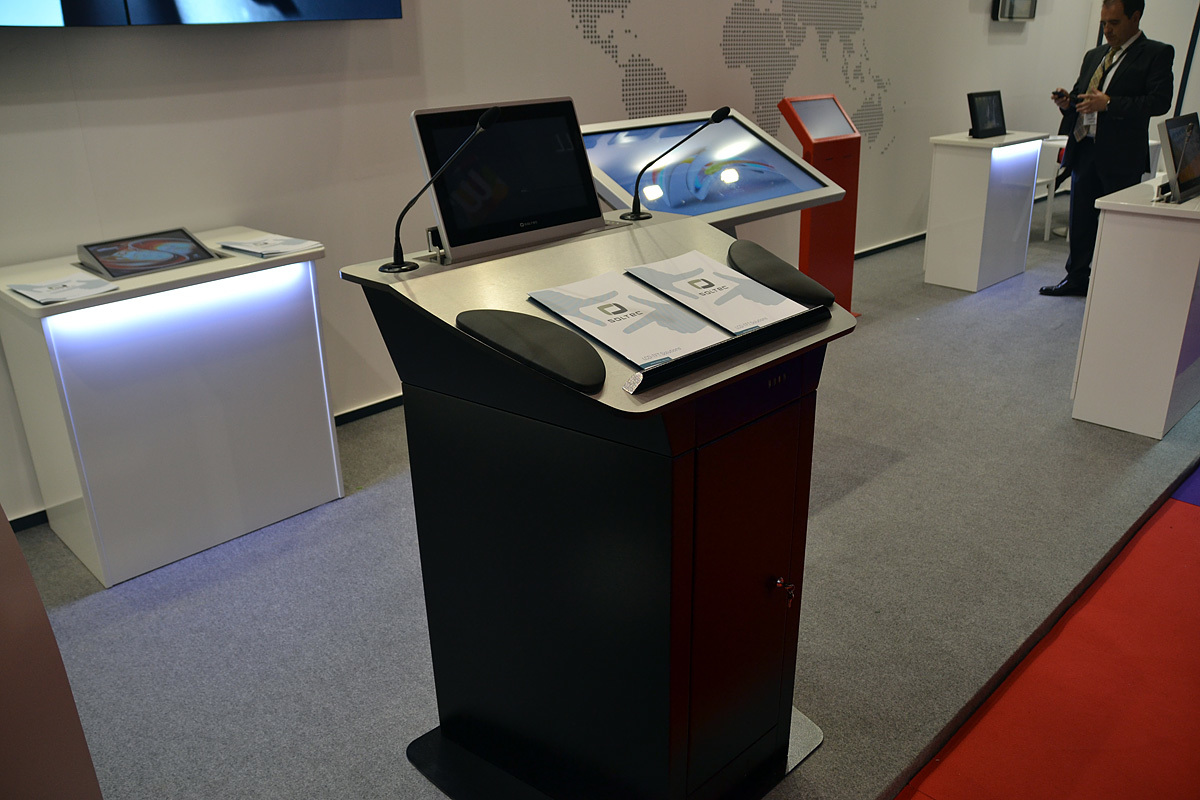
Ready-made systems and even individual elevators are cheaper due to competition - at least 3 major manufacturers have entered this market.

It is very good that such indoor displays began to appear:

This electronic ink, that is, E-Ink-displays. There were only a couple of stands. These are very good solutions for open offices. Considering that in a passive state (without power) they continue to show a picture (energy is spent only on updating), 10 years of work for offices from one battery are declared. I do not really believe in it, but at five - very much so. And there are panels immediately from the radio - this was the second life of the pre-idle control channels (Wi-Fi and Bluetooth eat too much power), which is energy efficient.
There were a lot of autostereoscopic displays (3D without glasses). But there will be no slides - the focus will not succeed, we must look at it personally. It is important to say that my colleague is unreal sick of all kinds of 3D (the occulus he wears is not more than 30 seconds) - and here it is normal, not sick even near large screens.
In our 3D lab we have displays that are clearly visible from a certain point (then artifacts or seams of translucency begin), and these are good from all sides.
And this is how those who did not invent cool new technologies attracted to themselves, and simply labeled everything as before:

Here is the Big Brother ordered new pieces of iron:

Determines the head, then on it - facial expression, gender, and on the basis of this - the current emotional state. Able to distinguish beards, glasses, etc. (they have for advertising signs "bespectacled", "bearded", "in the hat" and so on).

And there was also a camera, which has great practical significance in Russia. The fact is that we have one of the most frequent tasks in organizing video conferencing - this is “make sure that the boss is not red on the screen”. This is an obligatory thing that is asked in large companies. Here the cameras are easily adjusted by the remote control (literally a couple of buttons) and now everyone will have beautiful and healthy colors. The consoles and cameras are greatly enhanced - here and the sea of interfaces from USB 3.0 to HDMI - to smooth motion. No jerks. Nearby was a 4K camera, so she jerked.
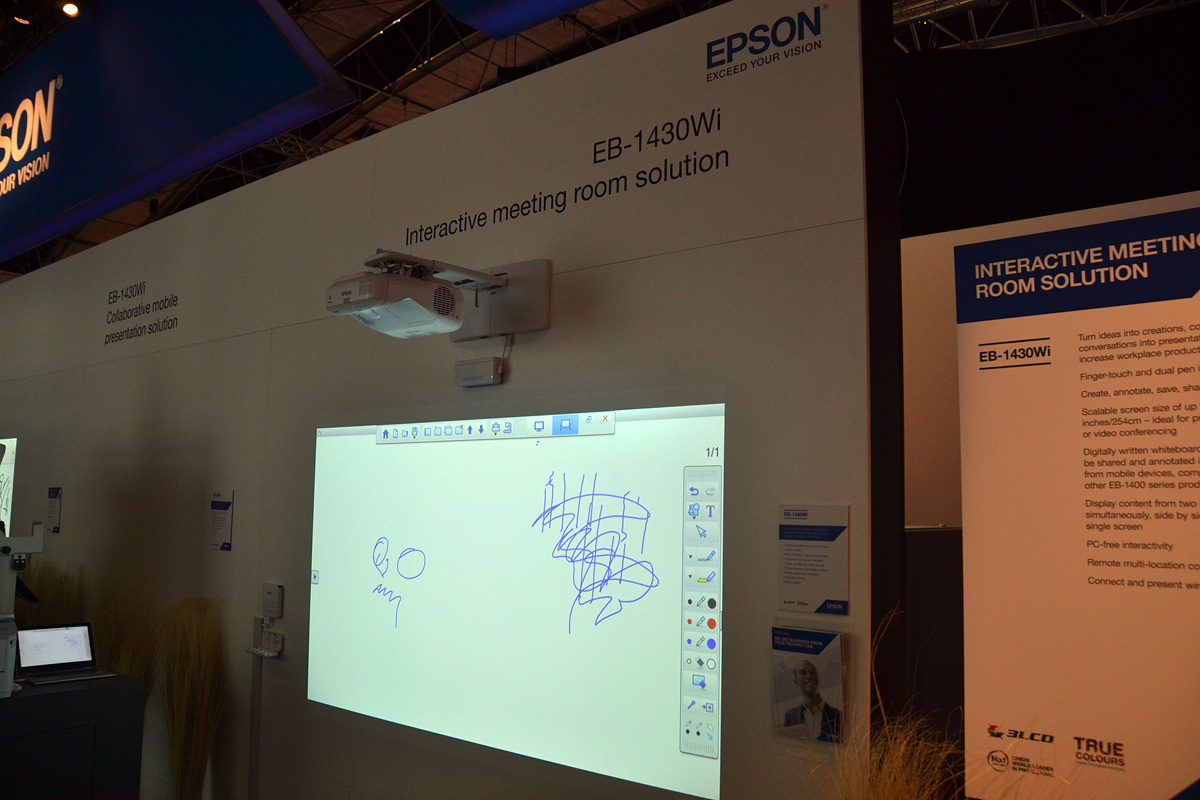
There were projectors with a lens that allows you to beat really close. Plus they are now laser - sort of brighter and cooler. Again, the stitching became better, and through the systems of mirrors they learned how to cover complex objects like temple domes. 360 degrees on two projectors is now no problem at all.
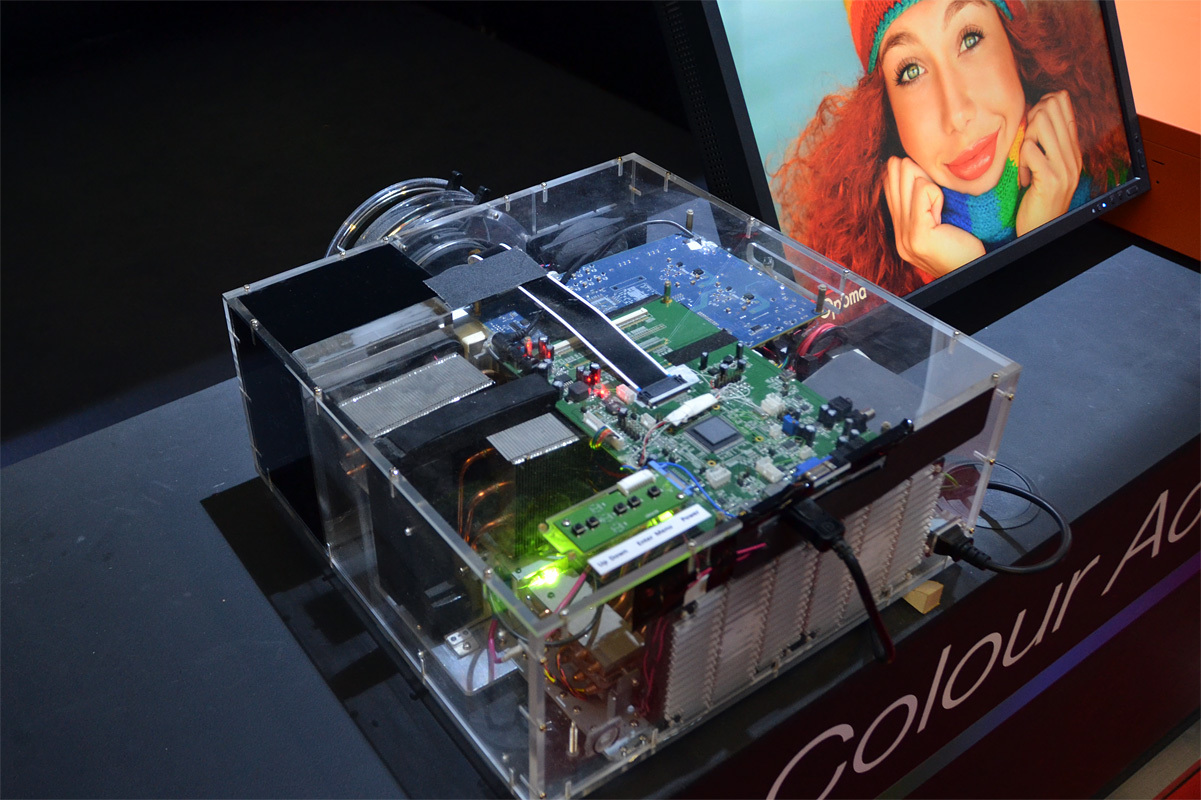
This is exactly the Optoma laser projector in a transparent case. 20 thousand hours - in fact less than some lamps. But the color rendition is amazing. At the following exhibitions we are waiting for new options - cheaper and more reliable, this is a question of running in technology.
Good big table:

Many mirror displays for hotels and fitting rooms. Soon they will learn to say “You are coming” after recognition:

The most powerful laser projector exhibition for 30 thousand lumens:

Freeform Displays:

In the end, the installer’s happiness, a universal cabinet for “giblets” with a bunch of adapters and cables:

This is a whole box for small receiving-transmitting devices - there are lattice boards for any devices (they are for cogs and screeds). And a large power supply, which has outputs for all popular connectors. No need to hold wires and power supplies. And, most importantly, the cabinet is inexpensive. Plus all the necessary outputs from tulip to HDMI.
Here is another interesting concept:

But these things are still very expensive, but already impressive:

And in five years they will probably be everywhere.
Here is a report from the exhibition last year, and just in case my email is: PPochtennov@croc.ru
Source: https://habr.com/ru/post/278429/
All Articles